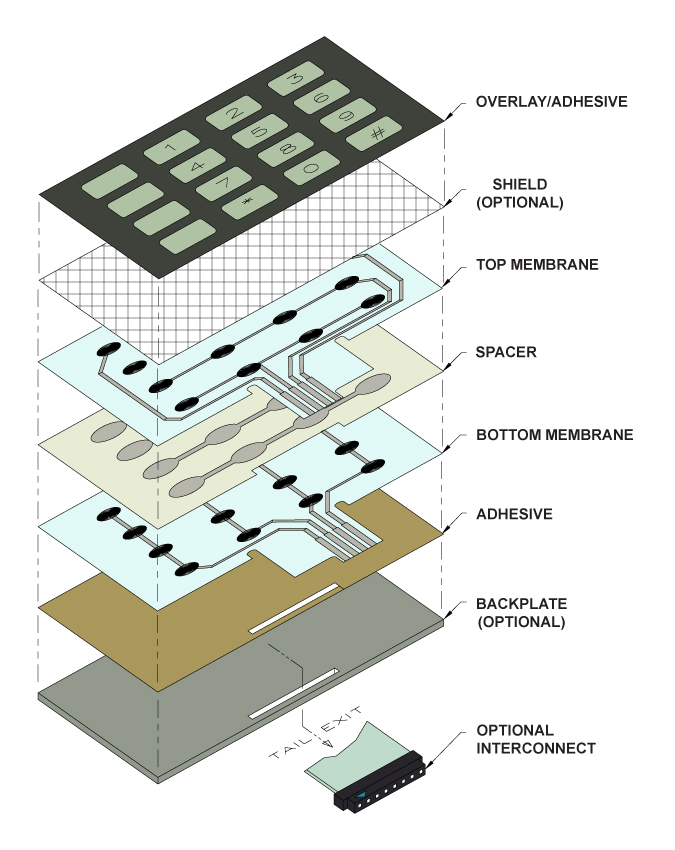Comprehending the Performance of Membrane Layer Switches Over for Interface Gadget
The capability of membrane layer switches represents a considerable improvement in customer interface design, combining efficiency with aesthetic adaptability. As markets significantly prioritize individual experience, recognizing the nuances of membrane button technology ends up being essential.
What Are Membrane Switches?
Membrane layer buttons are cutting-edge interface gadgets that facilitate individual communication with digital tools. These versatile components contain numerous layers, consisting of a visuals overlay, spacer, and a printed circuit layer. The layout enables a smooth combination into different electronic devices, boosting both the visual and practical elements of user interfaces.
Membrane layer switches are typically employed in a wide variety of applications, from household devices to industrial equipment and medical tools. Their building and construction generally includes a thin profile, making them an excellent choice for portable styles. The tactile responses offered by these buttons can be engineered to fulfill specific customer preferences, making certain reliable interaction in between the user and the gadget.
Longevity is one more significant benefit of membrane buttons, as they are resistant to dirt, dampness, and chemicals, which enhances their lifespan in requiring atmospheres. Additionally, these buttons can be tailored in terms of shape, dimension, and graphic design, permitting branding and user-specific features. Generally, membrane layer switches represent a sensible service for boosting user experience in electronic tools, combining performance with visual appeal in a reliable way.
How Membrane Switches Over Job
Operating on a simple principle, membrane layer switches make use of a split construction to sign up customer input efficiently. Each button includes several layers, including a published circuit layer, a spacer layer, and a top visuals layer, which are created to work together effortlessly. When an individual presses the leading layer, it compresses the spacer layer, bringing the conductive elements of the circuit layer into call with each other.
This call creates a shut circuit, signaling the device to implement a certain function. The design permits different setups, consisting of responsive responses, which can improve the individual experience by offering a physical sensation upon activation. The products made use of in membrane layer buttons usually consist of adaptable substrates, such as polyester or polycarbonate, which make sure sturdiness and durability against wear and tear.

Secret Advantages of Membrane Layer Switches

An additional considerable advantage is their compactness. Membrane buttons are slim and light-weight, which enables producers to save room in their gadgets without compromising capability. This attribute is particularly helpful in applications where weight and quantity are essential factors to consider.
Furthermore, membrane layer buttons are immune to dust, dampness, and chemicals, improving their durability. This durability extends their life expectancy and lowers the need for constant replacements, leading to cost financial savings with time.
Moreover, the tactile responses given by membrane layer switches can be maximized to boost individual interaction. They can consist of features read this article such as elevated buttons or distinct clicks, enhancing usability and customer experience.
Applications Throughout Industries
Interface gadgets utilizing membrane switches prevail in a broad array of markets, showcasing their flexibility and functionality. Membrane Switch. In the medical market, membrane layer switches are essential to gadgets such as analysis tools and patient monitoring systems, where their toughness and convenience of cleansing are essential for keeping hygiene standards. In the auto industry, these buttons are employed in control panel controls and infotainment systems, offering a smooth and modern user interface for customers.
Additionally, the customer electronics industry take advantage of membrane switches in devices and handheld gadgets, where compact style and straightforward interfaces enhance individual experience. Industrial applications additionally utilize membrane changes for control panels in machinery and automation systems, stressing their robustness and resistance to harsh environments.
In the aerospace and protection sectors, membrane switches are used in cabin controls and equipment, where reliability and efficiency under extreme conditions are additional info vital. In addition, the pc gaming sector increasingly includes membrane layer switches in controllers and arcade equipments, adding to an appealing user experience. Generally, the versatility of membrane layer switches over enables their extensive use across numerous industries, emphasizing their importance in contemporary customer interface style.
Future Fads in Membrane Change Technology

Additionally, the use of sophisticated products, such as polycarbonate and polyester movies, is anticipated to rise, supplying boosted resilience and resistance to ecological stress factors. These products add to the total long life of membrane buttons, making them suitable for harsher industrial applications.
Moreover, the consolidation of wise technology, consisting of IoT connectivity, will enable membrane layer switches to communicate with other devices and systems, facilitating a much more interactive customer experience. This trend aligns with the growing need for clever tools across various fields, from medical care to consumer electronics.
Lastly, personalization choices are prepared for to increase, allowing suppliers to produce bespoke services customized to details user demands and choices. These advancements will certainly position membrane buttons as crucial elements in the evolution of individual interface modern technology.
Verdict
In conclusion, membrane layer changes represent a critical innovation in individual interface innovation, offering a reputable and versatile option for varied digital applications. Their split building and construction helps with compact layout, while attributes such as responsive comments enhance customer communication. The resilience against ecological aspects better solidifies their utility across several industries. As advancements in material scientific research and touch picking up innovations continue, the performance and applicability of membrane layer switches are anticipated to increase, reinforcing their importance in modern digital tools.
Comments on “Discover How a Membrane Switch Boosts Toughness and Capability in Instruments”